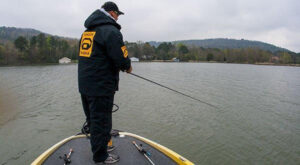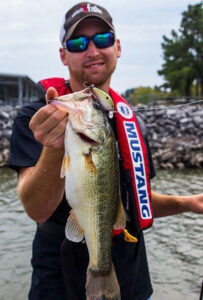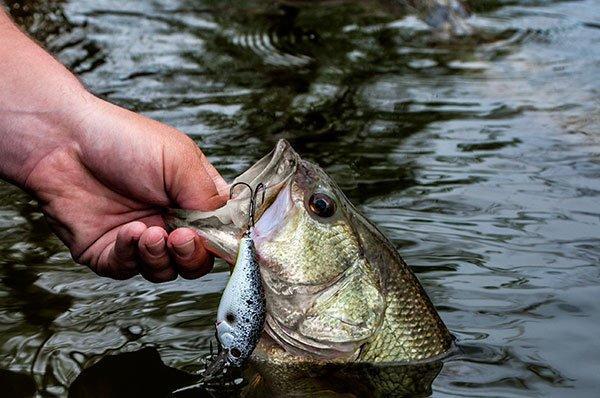It’s finally Saturday, and you’ve been waiting all week long. Through all of the hustle-and-bustle at work, taking the kids to practice and the busy activities of the weekdays, this tournament has been in the forefront of your mind. You and your fishing buddies have been dogging each other all week via text messages claiming premature victory and trading fishing stories about each other’s successful practice days. Now it’s time to “put up or shut up.”
You pull up to your first spot—a long, tapering primary point close to the launch site. The fish have been here all week, and it should be a quick crankbait limit. With other tournament anglers still blasting off in the distance, you chuckle to yourself at the thought of catching a solid limit before your competitors have even reached their starting spots. If they only knew …
You pick up your cranking rod and fire a crankbait across the point. A foot of slack gets knocked into your line, but you can’t connect with the hungry bass. You shake it off and make another long cast. Another slap, and this time you stick the fish for a few seconds before it throws your crankbait, leaving just a single cheek scale hanging on the back treble hook. After working the point for what seems like hours, there’s not a single fish in your livewell. Both the bass and bait are all over the graph, so what’s the deal?
Many anglers overlook the importance of crankbait cadence when fishing during the fall. If you know the fish are there, and you’re not getting bites, don’t give up. These three simple retrieval modifications can not only change the mood of the bass but your ability to land the bass in an area.

Slow your roll
We all at times lose our focus and mindlessly reel our crankbaits without giving any thought towards our retrieval speed. It’s an easy mistake to make because, if we’re honest about it, we’ve all caught plenty of fish doing this. When the fishing slows, perhaps during post-frontal conditions, minding your retrieve and reducing your speed can produce more bites.
This can be particularly true when a front rolls through and makes fishing tough. In post-frontal conditions, bass don’t feed as aggressively as they normally do. Instead, they tend to position tightly to cover and less apt to chase. The fish can be all over your graph, but won’t touch any crankbait that you throw their way. To combat the tough conditions, slowly retrieving your crankbait—just enough to barely feel it wobble—can yield some great results.
It is important to note that when you slow down your crankbait retrieve to this degree, your crankbait will unavoidably lose some running depth. In order to get around this, lower your rod tip while “kneeling and reeling” to keep the lure in the strike zone for a longer period of time.
Kamikaze
Fall is notorious for schooling bass, and an erratic retrieve proves a killer for these situations. When the pods of shad are visible and the bass are blowing through the bait, irregularity attracts bass and puts more fish on your bait.
How many crankbaits do you think bass see in a year—hundreds? Maybe thousands? I can’t emphasize enough the importance of differentiating your presentation from the ones that bass see every day of their lives. In order to get the most out of schooling bass, fishing crankbaits almost like a jerkbait perfectly emulates a wounded shad. Think about it: Bass are purely opportunistic predators and will always opt for the easiest meal. If they can attack a wounded shad while exerting less energy, they are going to do it 100-percent of the time.
To exploit the bass’ weakness for wounded prey in schooling situations, make long casts past both the bait and bass. Crank your crankbait down to the desired depth, and follow with several series of quick, sporadic jerks accompanied by intermittent pauses. Often times the bass will hit the bait on the pause, so always make sure to watch your line and swing for the fences when it jumps even the slightest bit.
In order to obtain the best action, it is best to use a 7-foot, medium-power, fast-action rod with high quality monofilament, such as 12-pound Sunline Super Natural Monofilament.
Kick things up a notch
There aren’t many things more fun than burning a crankbait and having a bass hit it so hard that it stops your reel in its tracks. Contrary to popular belief, a speedy cranking retrieve isn’t just for fast-action situations.
This time of year in the early fall season, bass can get flat-out obstinate, slapping and swatting at your crankbait until your wit’s end. If you do finally catch one, it’s usually barely hooked by the back treble hook. To drastically reduce the amount of short strikes, drastically increasing the speed of your retrieval can surprisingly turn swatting bass into eating bass, especially in clear-water conditions.
In clear water, you never want a bass to get too good of a look at your crankbait. The longer they look at it, the better they will be able to detect any unnatural attributes. While many people think that short-strikes are an indication of sluggish bass, many times it is because you’re giving them too long to decide whether or not to eat your crankbait.
“If a crankbait won’t run true at the fastest speed, it’s a piece of junk to me because I need the speed option,” Skeet Reese said in a recent interview.
Simply increase your retrieval speed in order to draw pure reaction strikes from the bass. A quickly-moving lure whizzing by the head of a hungry bass triggers its predatory instincts to attack, which can produce some great catches from otherwise wary bass. Utilizing this method can be made much easier by using a high-speed cranking reel, such as a 7.1:1 Lew’s Speed Spool Casting Reel.
At Wired2Fish, we’re constantly looking for ways to catch “one more fish.” If you make it a point to implement these three simple retrieval modifications this fall, you could be on to one of your best cranking seasons. Slow down, speed up and change it up until you figure out what works for the group of bass you’ve found.












